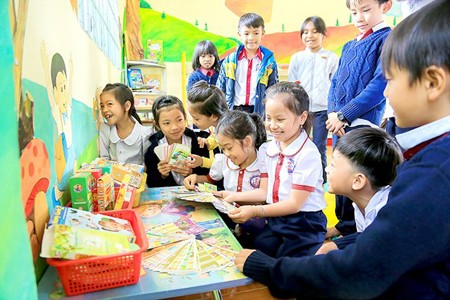
Libraries without book borrowing!
According to Mr. Tran Tuan Anh, Head of the Division of Primary Education under the Thai Binh Province Department of Education and Training shared that formerly, pupils could only read books in their 5-to-7-minute break time between lessons, including 2 minutes for book checking in and out. In addition, the reading space was very limited while the number of pupils is always high, making them feel cramped.
The most disadvantageous point is that due to the limit in the number of books, libraries normally could not let readers take books home while parents cannot afford to buy books for their children. All lead to the fact that on average, a pupil, especially those in rural areas, read only 2 to 3 books per year.
Except for large cities like Ho Chi Minh City or Hanoi, libraries in other areas still lack many facilities and book titles.
According to the Department of Primary Education under the Ministry of Education and Training, in the whole nation, only 17 percent of primary schools have their own library. Nearly 80 percent of libraries are for both teachers and pupils, which means the latter group does not have their own reading space. 4 percent of primary schools do not have any space for reading activities at all.
Even one-third of libraries in schools can neither meet the space requirement nor have a specialized librarian.
The limit on the facilities and human resources leads to ineffective use of libraries themselves. Only 60 percent of libraries open daily in an academic year, nearly a half of which do not have any reading-related activities. A half of current libraries do not allow book borrowing, meaning these buildings are just a formality.
Dr. Nguyen Huu Do, Deputy Minister of Education and Training commented that it is the librarians and teachers who can evoke the reading interest among children. Yet in reality, creating a reading habit for children is a tricky question.
Cooperation to form reading habit
Understanding the importance of reading habit, each area in the country is trying to find its own method to tackle the problem.
The northern province of Thai Binh has introduced the model ‘Parents’ Bookcase’, collecting books from benefactors and parents. The bookcase will be monitored by pupils themselves. As a result, until now, there are around 4,700 book cases created, increasing the average number of books read by children by 5 to 10 times. In some areas of the province, pupils even read 20 to 30 books a year.
The drawback of this method is the expense on bookshelves, the arrangement and classification of books, and the maintenance of books, since it is pupils who take care of the last two matters. Yet they have very limited knowledge on this.
Therefore, when the model of ‘Friendly Library’ of the Room to Read Foundation (RtR) is piloted in many provinces, there is profound support and positive comments. As said by Dr. Nguyen Huu Do, the most prominent feature of RtR is the training for librarians and teachers on how to attract children to books.
Mr. Nguyen Duc Huu, Deputy Director General of the Department of Primary Education, RtR has brought a standard to choosing suitable books for children in accordance with their psychological development.
RtR introduced a color code table for six different kinds of bookshelves. The green color is for grade-one books; red for grade one and two; orange for grade one, two and three; white for grade two, three, and four; blue for grade three, four, and five; and yellow for grade four and five. This classification is based on various scientific qualitative and quantitative researches on linguistics.
The ‘Friendly Library’ also create the criteria of space, facility arrangement, light, decoration to better serve reading-related activities.
As said by Mr. Huynh Tan Minh, representative of the Tra Vinh Province Department of Education and Training, after two years of successfully piloting the model, the awareness of schools on libraries has been deeply changed. The quality of language-related subjects has increased. This is a very positive signal of the benefits of reading habits.
Room to Read is a Non-Governmental Organization founded in 2000 in Nepal. Its head office is located in the USA. The model ‘Friendly Library’ of RtR has been piloted in 16 provinces in Vietnam, with around 1,357 libraries being built and having nearly 3 million books. Based on this model, other provinces have also created over 500 libraries for primary schools.
























